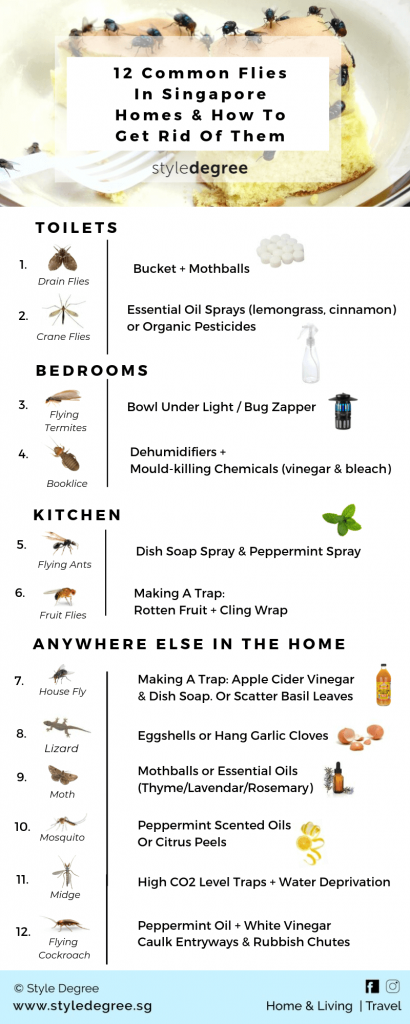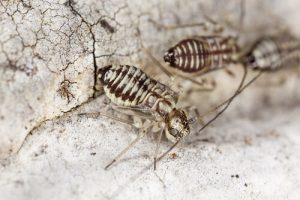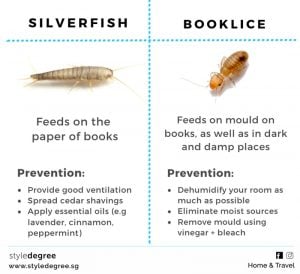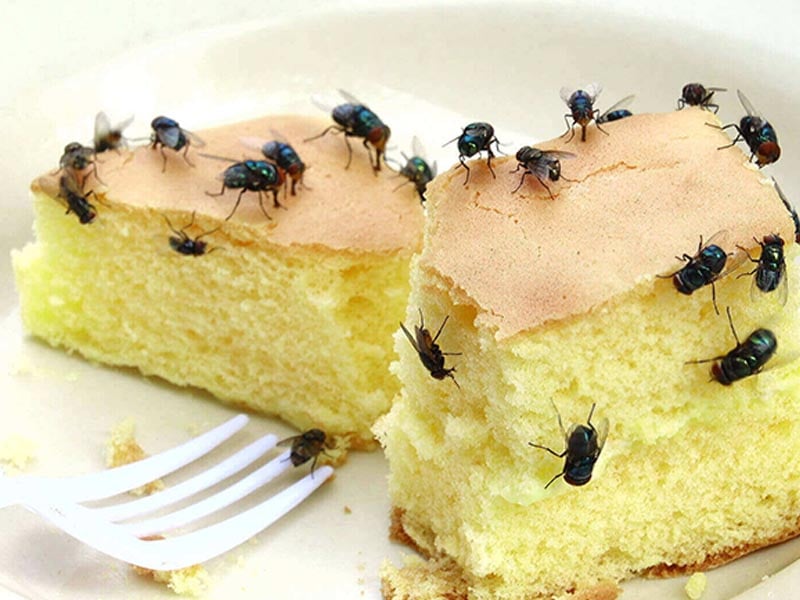Flies and insects has always been a huge bother to Singaporeans, especially when the humidity cranks up during the rainy season. The mere sight of a few of them causes us to cringe, so an infestation is unimaginable. Worry no more, these hacks are here to help you with driving the nasty flying pests away from your home!
Save and share this handy infographic that sums up the methods to get rid of those annoying insects from your home. Read on to learn about preventive measures, in-depth solutions you can take to save your home!

Click on each insect to navigate directly to the specific solution!
- Drain Fly
- Crane Fly
- Flying Termite/Rain Fly
- Booklice
- Flying Ant
- Fruit Fly
- House Fly
- Lizard
- Moth
- Mosquito
- Midge
- Flying Cockroach
Toilets
1. Drain Fly

Image source: Town and Country Solutions
These little guys may look like mini-moths, but they’re a nuisance around toilet drains and walls. Give them too much time to grow, and you get a nasty infestation.
Solution:
Here’s a way to remove them: place a bucket and some mothballs under it, over the drains. When they come out, they’ll be trapped, and die off. Repeat this for at least 15 days to eradicate them completely as that’s the life cycle of drain flies.

Image source: Superchrisho
2. Crane Fly

Image source: Thoughtco
Many-a-time, they’ve been mistaken for mosquitoes or spiders, because of their spindly long legs. The crane fly tends to hang around toilet walls and bowls, as they need a source of moisture to lay their eggs.
Solution:
The best 3 defences against them are organic pesticides and essential oil sprays, like lemongrass and cinnamon! To prevent any crane fly sighting, keep the toilet as dry as possible, especially after heavy rainfall.
Bedrooms
3. Flying Termite (Or Rain Fly)

Image source: Pestwiki
Similarly to the crane fly, they’re attracted to moisture in your room. The method to deal with them? Give them the best of both worlds!
Solution:
Place a bowl of water under a light source, near the group. The reflection will lure them to their watery demise, and you can simply toss the contaminated water down the drain afterwards. A more preventive step is to place a bug zapper near your window, to keep these intruders out.
Fun Fact: Flying termites are also known as rain flies because they tend to use the heat coming from lights to dry themselves right after a bout of rain.
4. Booklice

Bookworms who treasure their tomes dearly, keep an eye out for this one. Booklice thrive in humid climates, and their primary targets are places that can retain moisture. This gives rise to mould, which they can feed on. One prime example: they feed off the mould in your pages. Prepared to brandish weapons at that thought?
Solution:
Dehumidifiers and mould-killing chemicals are your allies. Cedar Moth Balls is one of the solutions! In fact, it is highly encouraged compared to regular mothballs, as it is less toxic.
Cedar Moth Ball & Dehumidifier Hanging Holder
Booklice & Silverfish: Are They The Same?
Booklice sometimes can get mistaken for Silverfish, as they both ruin books. But there are subtle differences between them! This table will show you how they’re not alike:

Kitchen
5. Flying Ant

Image source: Pest Control
Like regular ants, they’re attracted to leftover food. However, as they can fly, they have an added advantage and can’t simply be smacked with a rolled up newspaper. They can easily dodge by taking off, so it’s better to target the air.
Solution:
Using dish soap or peppermint spray on the flying ants will dehydrate them as the solutions stick to their bodies easily. Another sticky solution is to use tape. Simply place transparent tape near their food sources, and watch the magic work.
Also check out on StyleMag: 3 Natural Ways To Get Rid Of Ants Fast
6. Fruit Fly

Image source: Campus Rankings
This is an annoying, but common sight you’ll see in the kitchen. Wherever there’s leftover food, you’ll find the flies flitting around. The one-size-fits-all is to keep your kitchen clean at all times, but sometimes the stray leftover may go unnoticed by human eyes.
Solution:
To prevent infestations, turn the fruit fly’s greatest love – food into an enemy it won’t see coming. Place rotten fruit compost in a bowl, cover it with cling film. Poke small holes into the plastic… and the trap is set up!

Image source: My Kids Time
Anywhere In The Home
7. House Fly

Image source: iproperty
They may look harmless, but they will land anywhere in the home. They can spread diseases, if unchecked too.
Note: House Flies are more dangerous compared to Fruit Flies. House Flies settle in all types of premises and are not partial to what they feed on, whereas Fruit Flies focus more on decaying fruit or fermenting food products.
Solution:
Similar to the fruit fly trap, pour a mixture of dish soap and apple cider vinegar in a glass jar, and line the jar with paper shaped into a cone. Once the flies get in, they won’t be able to leave, and you can dispose of them. To deter them, the smell of herbs like basil will do a good job at driving them away.

Image source: Lil Luna
8. Lizard

Image source: akshintel
While you might be “shoo-ing” lizards away to have them scramble into crevices, they’ll stealthily still leave traces of their poop on walls and surfaces.
Lizards prey on insects (e.g flies, spiders, mosquitoes) and they love nibbling on fruits and vegetables. That’s why you might spot them on your kitchen countertop too. Prevent your food from being a lizard’s meal with a food cover.
Solution:
The best prevention to attracting lizards to your home is to keep them uncluttered. They love hiding in clutter, slipping into cracks, feasting on scraps, and puddles of water. For a natural solution, lay eggshells or garlic cloves around areas where you often spot lizards.
| What lizards LOVE | What lizards HATE |
| 1. Food & Water 2. Flies & Crawling Insects 3. Well-lit areas 4. Warm and humid environment | 1. Eggshells – Birds feed on lizards. Scattering eggshells gives off an impression that they are in a dangerous territorial zone. 2. Smell of garlic 3. Cold environment |
9. Moth

Image source: Free Nature Images
Moths, unlike butterflies, will eat into your clothes. They tend to pop up in dusty areas, or places with artificial light.
Solution:
If you don’t want ruined scarves or shoes, the first go-to step is to place mothballs around the problem sites. The toxic fumes will kill off the moths, but they can pose a danger for homeowners who inhale the insecticide gas. For a less hazardous tip, spray essential oils (lavender, thyme, dried rosemary) in affected spots. As a deterrent, place sachets in and outside the home.

Image source: Auburn Pub
10. Mosquito

Image source: Mosquito Control
The real deal this time. The hot and wet season sees an increase in mozzie breeding, along with Dengue cases.
Solution:
Besides emptying water sources and depriving them of spots to lay eggs, try scents, like essential oils or fragrant candles with a peppermint scent. A more unique solution is burning citrus peels. Not only does that drive the mosquitoes away, it actually deodorizes your home!
Also check out on StyleMag: Natural & DIY Mosquito Repellents To Keep Dengue Away
11. Midge

Image source: AsiaOne
Due to the recent breakout on September 9th 2019, reported in ChannelNewsAsia, here’s how to take them out before they attack you. First of all, deprive them of water sources for breeding in your home. In this case, they’re like the Mosquito, but not deadly.
Solution:
As the midge’s body is small, use mesh screens for deterrence. For extra defense, set up high CO2 level traps along your windows. The UV light lures them in, and sucks them into a compartment where they will be fatally dehydrated.
12. Flying Cockroach

Image source: Terminix
Once a cockroach starts flapping its wings, it’s a step up from simply spraying Baygon and hitting it with a flip flop.
Solution:
Make sure to keep your doors and windows well sealed, before spraying the insecticide. Once it drops, you can easily locate and dispose of it. To deter cockroaches from entering your home, make sure your home is clutter-free, so they don’t have secretive spaces to breed. Line any entryway with a mixture of peppermint oil and white vinegar. If you find cockroaches coming in through your chute, seal the opening tightly using caulk, a waterproof filler and sealant.
Myth: Are pandan leaves a perfect cockroach repellent?
Answer: Not really. Research from Rentokil, a local pest control expert, says that although the cockroaches can be repelled, they won’t be killed by the pandan leaves. Plus, when the leaves dry up, cockroaches will turn to it as their food source.
A 100% prevention is not possible, even as you keep your home well-managed and clean. You’ll still see these insects from time to time. But these tips will at least help decrease the number of nasty surprises in your home!
Also Check Out: 4 Organizing Rules To A Beautiful & Tidy Kitchen Pantry for more tidying up tips!




